Evaluating Strategic Business Models in Air Transportation
VerifiedAdded on 2020/04/07
|17
|4586
|540
AI Summary
The assignment requires a comprehensive analysis of the air transportation industry with a focus on strategic management frameworks like the McKinsey 7S model, SWOT analysis, and business model innovation. By examining these tools' application within major players such as Emirates Air Line and The Emirates Group, students will explore how they contribute to organizational structure, competitive advantage, and market success. The paper should draw from existing literature, case studies, and empirical research to provide a well-rounded perspective on strategic decision-making in air transportation.
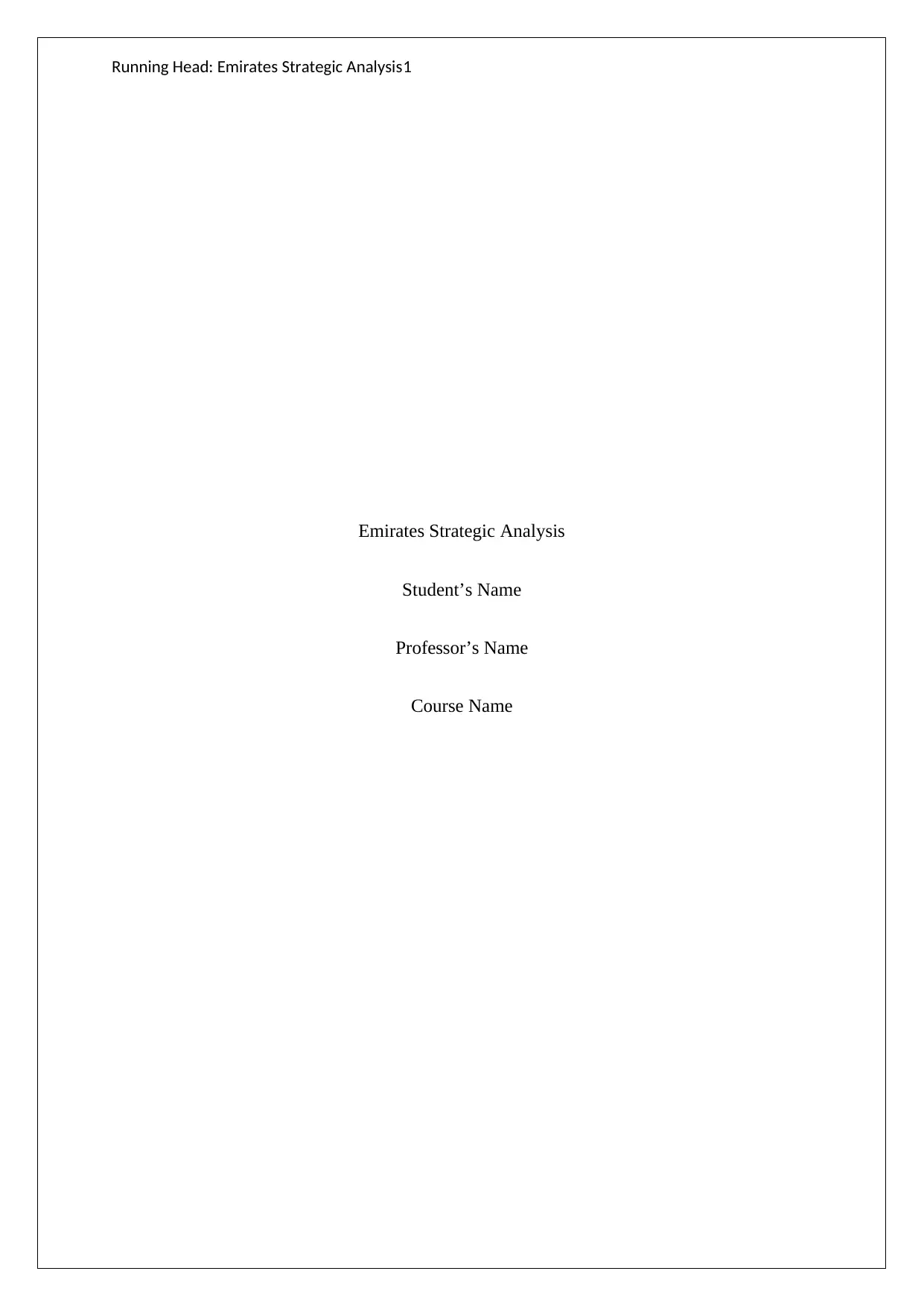
Running Head: Emirates Strategic Analysis1
Emirates Strategic Analysis
Student’s Name
Professor’s Name
Course Name
Emirates Strategic Analysis
Student’s Name
Professor’s Name
Course Name
Paraphrase This Document
Need a fresh take? Get an instant paraphrase of this document with our AI Paraphraser
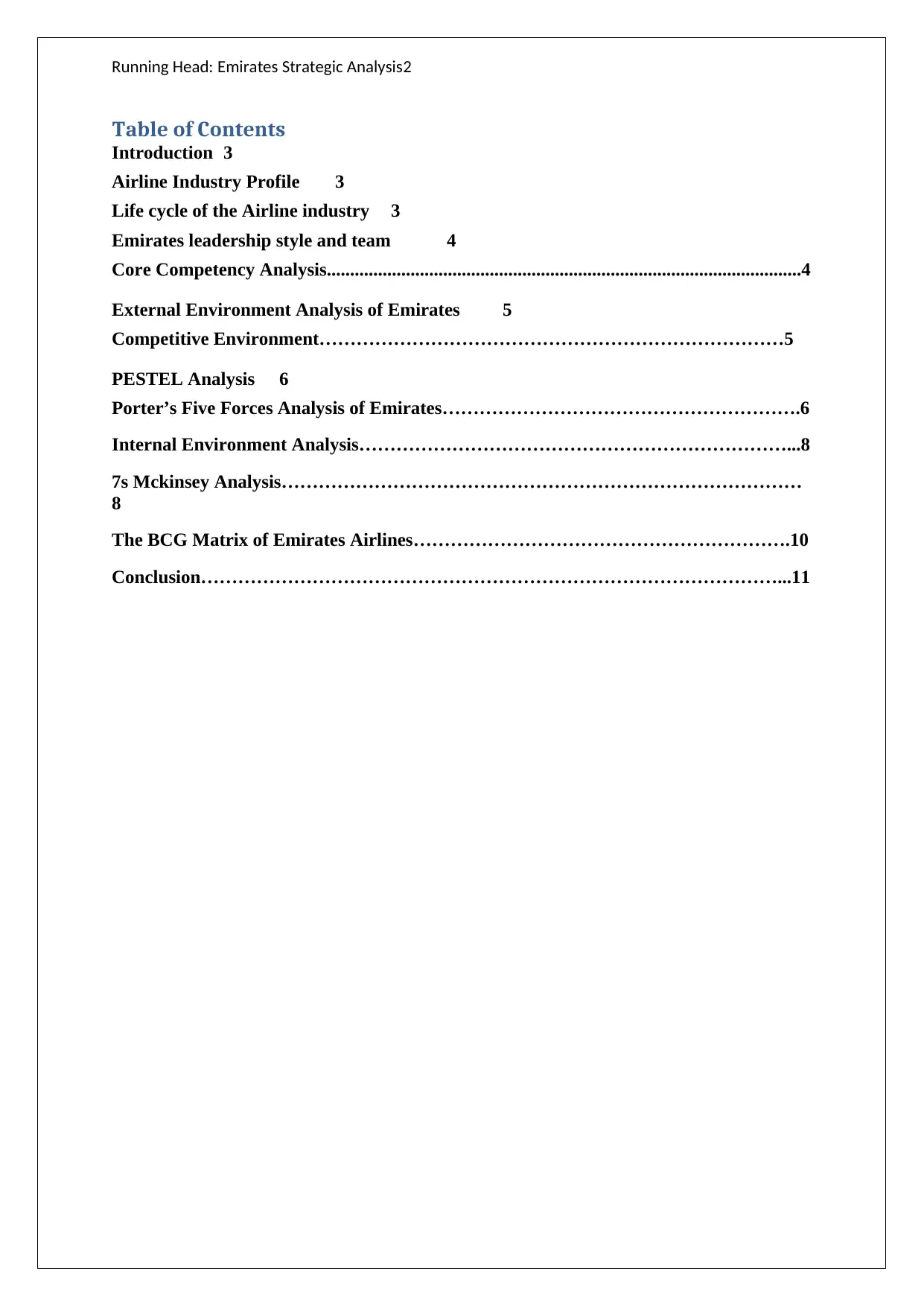
Running Head: Emirates Strategic Analysis2
Table of Contents
Introduction 3
Airline Industry Profile 3
Life cycle of the Airline industry 3
Emirates leadership style and team 4
Core Competency Analysis......................................................................................................4
External Environment Analysis of Emirates 5
Competitive Environment…………………………………………………………………5
PESTEL Analysis 6
Porter’s Five Forces Analysis of Emirates………………………………………………….6
Internal Environment Analysis……………………………………………………………...8
7s Mckinsey Analysis…………………………………………………………………………
8
The BCG Matrix of Emirates Airlines…………………………………………………….10
Conclusion…………………………………………………………………………………...11
Table of Contents
Introduction 3
Airline Industry Profile 3
Life cycle of the Airline industry 3
Emirates leadership style and team 4
Core Competency Analysis......................................................................................................4
External Environment Analysis of Emirates 5
Competitive Environment…………………………………………………………………5
PESTEL Analysis 6
Porter’s Five Forces Analysis of Emirates………………………………………………….6
Internal Environment Analysis……………………………………………………………...8
7s Mckinsey Analysis…………………………………………………………………………
8
The BCG Matrix of Emirates Airlines…………………………………………………….10
Conclusion…………………………………………………………………………………...11
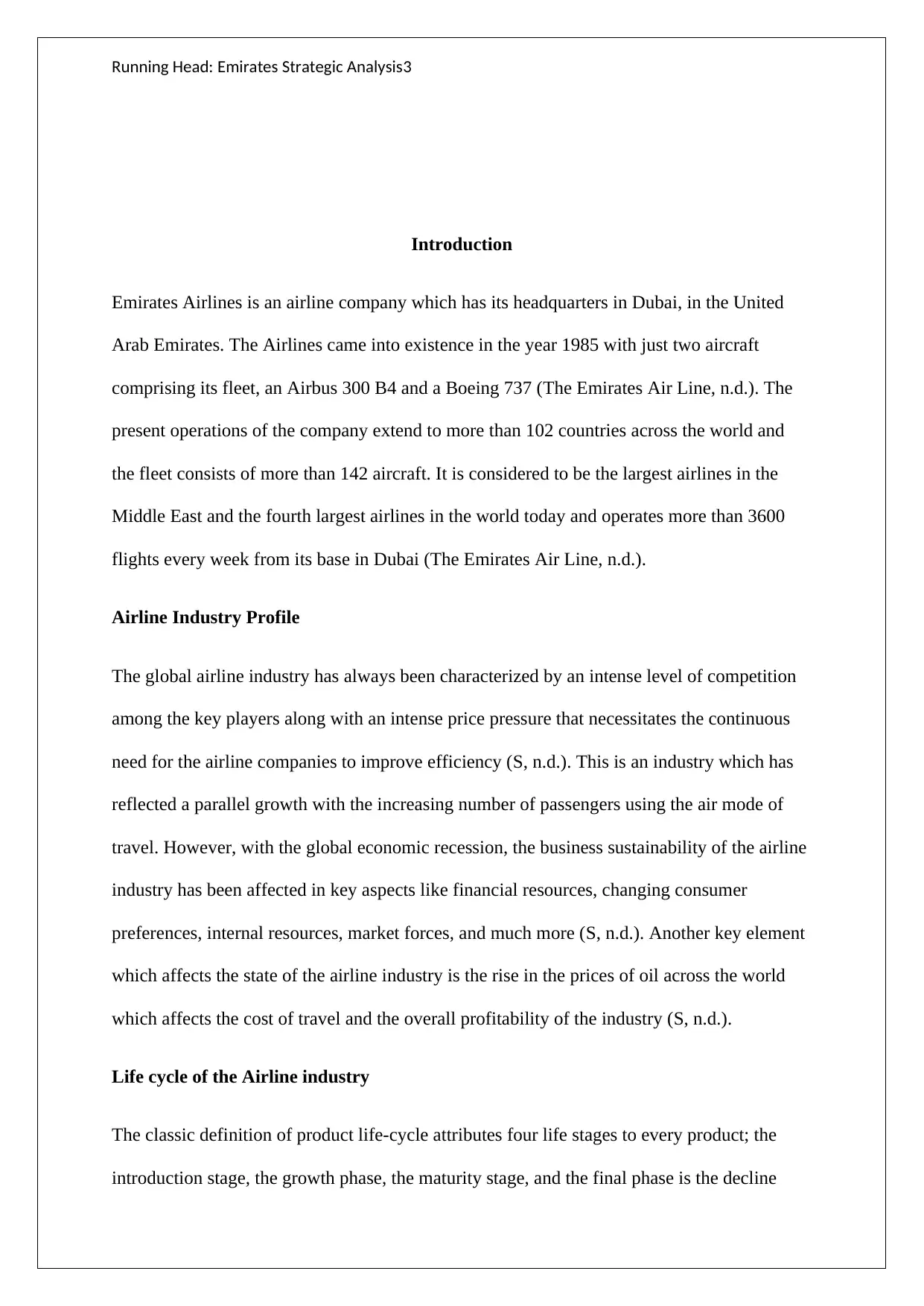
Running Head: Emirates Strategic Analysis3
Introduction
Emirates Airlines is an airline company which has its headquarters in Dubai, in the United
Arab Emirates. The Airlines came into existence in the year 1985 with just two aircraft
comprising its fleet, an Airbus 300 B4 and a Boeing 737 (The Emirates Air Line, n.d.). The
present operations of the company extend to more than 102 countries across the world and
the fleet consists of more than 142 aircraft. It is considered to be the largest airlines in the
Middle East and the fourth largest airlines in the world today and operates more than 3600
flights every week from its base in Dubai (The Emirates Air Line, n.d.).
Airline Industry Profile
The global airline industry has always been characterized by an intense level of competition
among the key players along with an intense price pressure that necessitates the continuous
need for the airline companies to improve efficiency (S, n.d.). This is an industry which has
reflected a parallel growth with the increasing number of passengers using the air mode of
travel. However, with the global economic recession, the business sustainability of the airline
industry has been affected in key aspects like financial resources, changing consumer
preferences, internal resources, market forces, and much more (S, n.d.). Another key element
which affects the state of the airline industry is the rise in the prices of oil across the world
which affects the cost of travel and the overall profitability of the industry (S, n.d.).
Life cycle of the Airline industry
The classic definition of product life-cycle attributes four life stages to every product; the
introduction stage, the growth phase, the maturity stage, and the final phase is the decline
Introduction
Emirates Airlines is an airline company which has its headquarters in Dubai, in the United
Arab Emirates. The Airlines came into existence in the year 1985 with just two aircraft
comprising its fleet, an Airbus 300 B4 and a Boeing 737 (The Emirates Air Line, n.d.). The
present operations of the company extend to more than 102 countries across the world and
the fleet consists of more than 142 aircraft. It is considered to be the largest airlines in the
Middle East and the fourth largest airlines in the world today and operates more than 3600
flights every week from its base in Dubai (The Emirates Air Line, n.d.).
Airline Industry Profile
The global airline industry has always been characterized by an intense level of competition
among the key players along with an intense price pressure that necessitates the continuous
need for the airline companies to improve efficiency (S, n.d.). This is an industry which has
reflected a parallel growth with the increasing number of passengers using the air mode of
travel. However, with the global economic recession, the business sustainability of the airline
industry has been affected in key aspects like financial resources, changing consumer
preferences, internal resources, market forces, and much more (S, n.d.). Another key element
which affects the state of the airline industry is the rise in the prices of oil across the world
which affects the cost of travel and the overall profitability of the industry (S, n.d.).
Life cycle of the Airline industry
The classic definition of product life-cycle attributes four life stages to every product; the
introduction stage, the growth phase, the maturity stage, and the final phase is the decline
⊘ This is a preview!⊘
Do you want full access?
Subscribe today to unlock all pages.

Trusted by 1+ million students worldwide
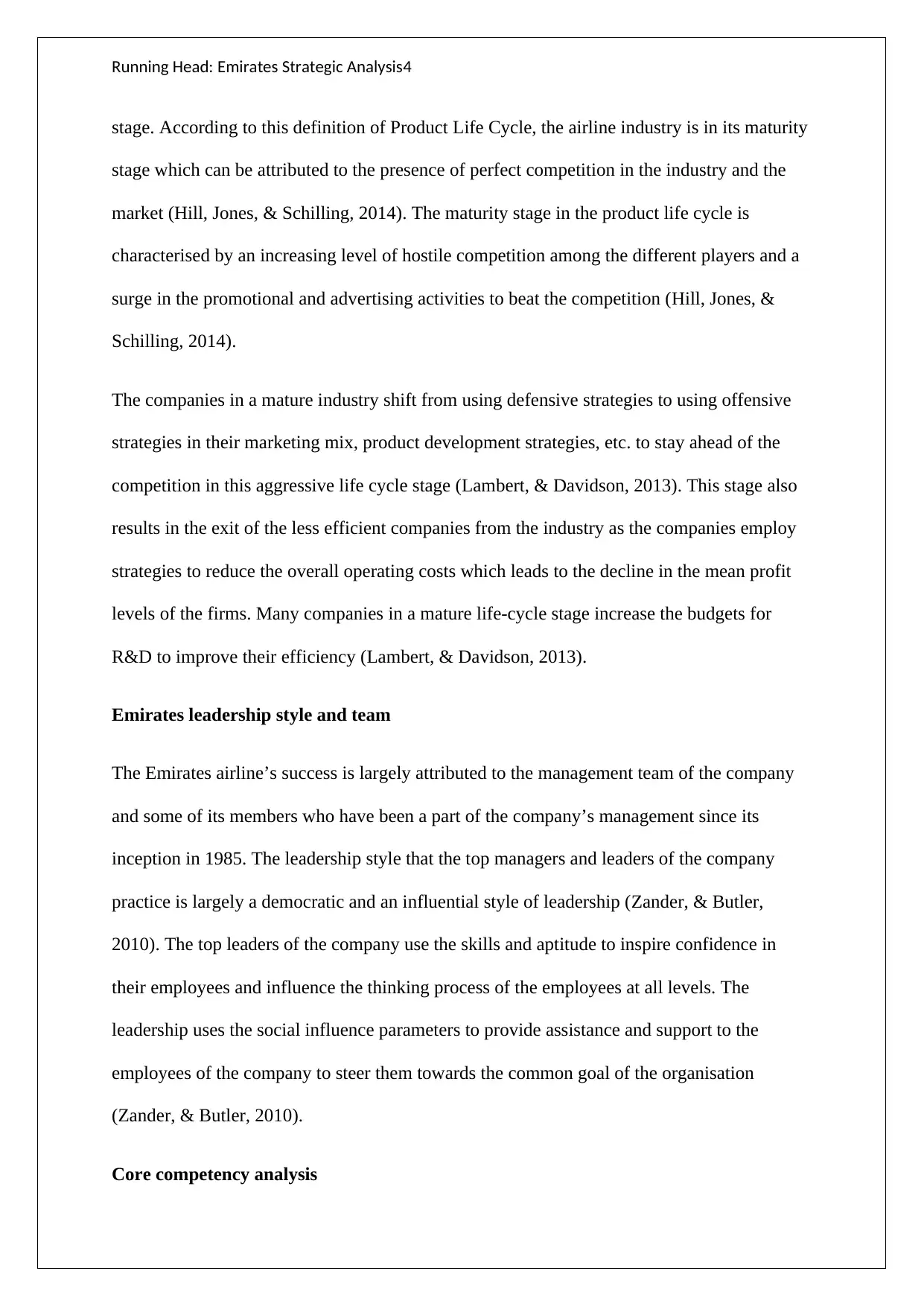
Running Head: Emirates Strategic Analysis4
stage. According to this definition of Product Life Cycle, the airline industry is in its maturity
stage which can be attributed to the presence of perfect competition in the industry and the
market (Hill, Jones, & Schilling, 2014). The maturity stage in the product life cycle is
characterised by an increasing level of hostile competition among the different players and a
surge in the promotional and advertising activities to beat the competition (Hill, Jones, &
Schilling, 2014).
The companies in a mature industry shift from using defensive strategies to using offensive
strategies in their marketing mix, product development strategies, etc. to stay ahead of the
competition in this aggressive life cycle stage (Lambert, & Davidson, 2013). This stage also
results in the exit of the less efficient companies from the industry as the companies employ
strategies to reduce the overall operating costs which leads to the decline in the mean profit
levels of the firms. Many companies in a mature life-cycle stage increase the budgets for
R&D to improve their efficiency (Lambert, & Davidson, 2013).
Emirates leadership style and team
The Emirates airline’s success is largely attributed to the management team of the company
and some of its members who have been a part of the company’s management since its
inception in 1985. The leadership style that the top managers and leaders of the company
practice is largely a democratic and an influential style of leadership (Zander, & Butler,
2010). The top leaders of the company use the skills and aptitude to inspire confidence in
their employees and influence the thinking process of the employees at all levels. The
leadership uses the social influence parameters to provide assistance and support to the
employees of the company to steer them towards the common goal of the organisation
(Zander, & Butler, 2010).
Core competency analysis
stage. According to this definition of Product Life Cycle, the airline industry is in its maturity
stage which can be attributed to the presence of perfect competition in the industry and the
market (Hill, Jones, & Schilling, 2014). The maturity stage in the product life cycle is
characterised by an increasing level of hostile competition among the different players and a
surge in the promotional and advertising activities to beat the competition (Hill, Jones, &
Schilling, 2014).
The companies in a mature industry shift from using defensive strategies to using offensive
strategies in their marketing mix, product development strategies, etc. to stay ahead of the
competition in this aggressive life cycle stage (Lambert, & Davidson, 2013). This stage also
results in the exit of the less efficient companies from the industry as the companies employ
strategies to reduce the overall operating costs which leads to the decline in the mean profit
levels of the firms. Many companies in a mature life-cycle stage increase the budgets for
R&D to improve their efficiency (Lambert, & Davidson, 2013).
Emirates leadership style and team
The Emirates airline’s success is largely attributed to the management team of the company
and some of its members who have been a part of the company’s management since its
inception in 1985. The leadership style that the top managers and leaders of the company
practice is largely a democratic and an influential style of leadership (Zander, & Butler,
2010). The top leaders of the company use the skills and aptitude to inspire confidence in
their employees and influence the thinking process of the employees at all levels. The
leadership uses the social influence parameters to provide assistance and support to the
employees of the company to steer them towards the common goal of the organisation
(Zander, & Butler, 2010).
Core competency analysis
Paraphrase This Document
Need a fresh take? Get an instant paraphrase of this document with our AI Paraphraser
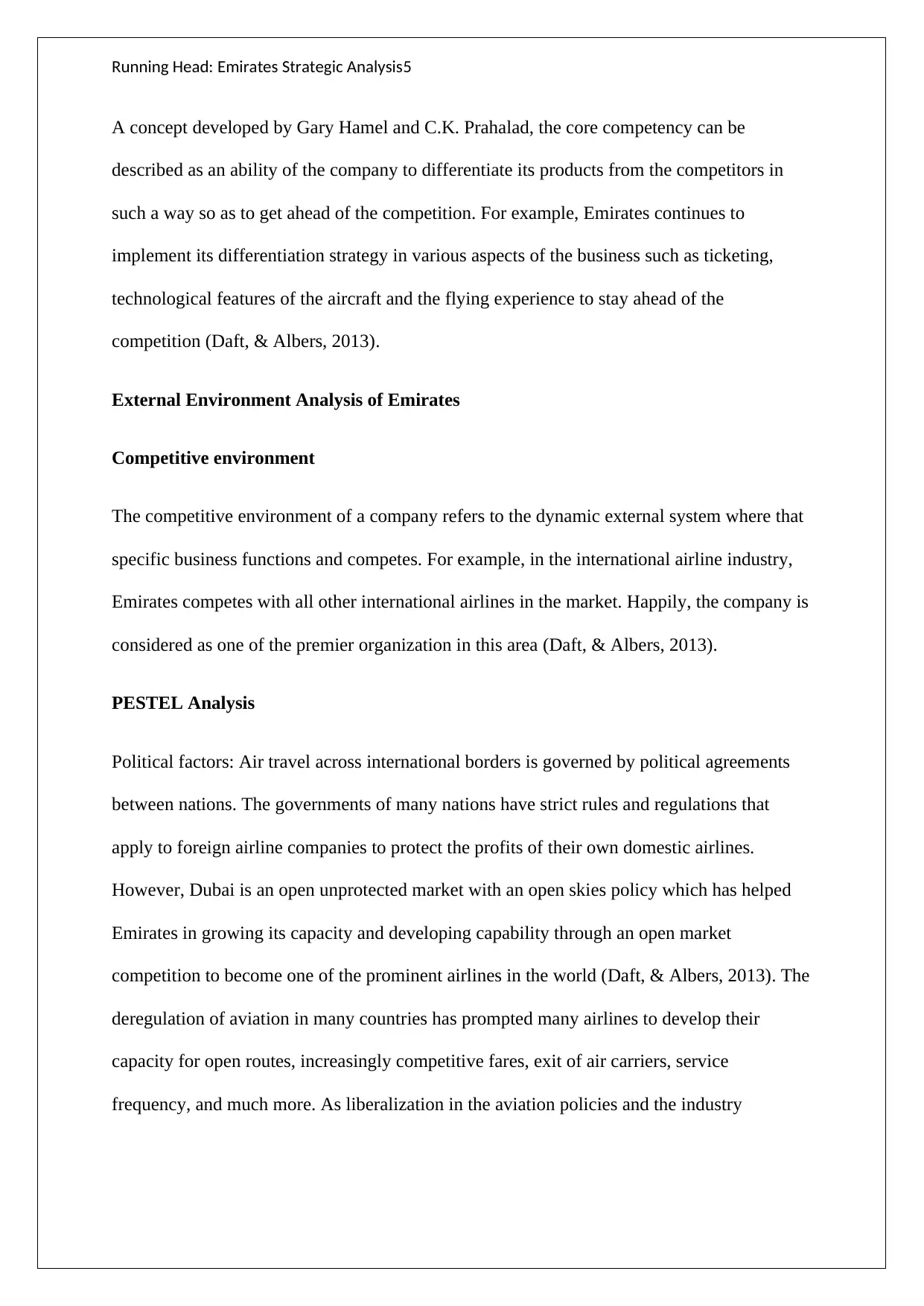
Running Head: Emirates Strategic Analysis5
A concept developed by Gary Hamel and C.K. Prahalad, the core competency can be
described as an ability of the company to differentiate its products from the competitors in
such a way so as to get ahead of the competition. For example, Emirates continues to
implement its differentiation strategy in various aspects of the business such as ticketing,
technological features of the aircraft and the flying experience to stay ahead of the
competition (Daft, & Albers, 2013).
External Environment Analysis of Emirates
Competitive environment
The competitive environment of a company refers to the dynamic external system where that
specific business functions and competes. For example, in the international airline industry,
Emirates competes with all other international airlines in the market. Happily, the company is
considered as one of the premier organization in this area (Daft, & Albers, 2013).
PESTEL Analysis
Political factors: Air travel across international borders is governed by political agreements
between nations. The governments of many nations have strict rules and regulations that
apply to foreign airline companies to protect the profits of their own domestic airlines.
However, Dubai is an open unprotected market with an open skies policy which has helped
Emirates in growing its capacity and developing capability through an open market
competition to become one of the prominent airlines in the world (Daft, & Albers, 2013). The
deregulation of aviation in many countries has prompted many airlines to develop their
capacity for open routes, increasingly competitive fares, exit of air carriers, service
frequency, and much more. As liberalization in the aviation policies and the industry
A concept developed by Gary Hamel and C.K. Prahalad, the core competency can be
described as an ability of the company to differentiate its products from the competitors in
such a way so as to get ahead of the competition. For example, Emirates continues to
implement its differentiation strategy in various aspects of the business such as ticketing,
technological features of the aircraft and the flying experience to stay ahead of the
competition (Daft, & Albers, 2013).
External Environment Analysis of Emirates
Competitive environment
The competitive environment of a company refers to the dynamic external system where that
specific business functions and competes. For example, in the international airline industry,
Emirates competes with all other international airlines in the market. Happily, the company is
considered as one of the premier organization in this area (Daft, & Albers, 2013).
PESTEL Analysis
Political factors: Air travel across international borders is governed by political agreements
between nations. The governments of many nations have strict rules and regulations that
apply to foreign airline companies to protect the profits of their own domestic airlines.
However, Dubai is an open unprotected market with an open skies policy which has helped
Emirates in growing its capacity and developing capability through an open market
competition to become one of the prominent airlines in the world (Daft, & Albers, 2013). The
deregulation of aviation in many countries has prompted many airlines to develop their
capacity for open routes, increasingly competitive fares, exit of air carriers, service
frequency, and much more. As liberalization in the aviation policies and the industry

Running Head: Emirates Strategic Analysis6
continues to grow, the competition among the key players is becoming equally fierce (Daft,
& Albers, 2013).
Economic factors: Jet fuel in an airline company accounts for approximately 40 percent of the
operational costs and therefore it is highly sensitive to any fluctuations in the oil and fuel
prices in the international market (Babatunde, & Adebisi, 2012). However, Dubai, the home
country of Emirates is an oil-rich company, remains an important factor in the growth of the
country. However, it is also prone to economic recession that continues to plague the country
(Babatunde, & Adebisi, 2012).
Social and Cultural factors: There has been a massive increase in travel for recreational,
educational and employment purposes and it has boosted the prospects of the airline industry
and Emirates has been a natural beneficiary of this increase due to its well-connected and
strategic network in all societies across the globe (Issa, Chang, & Issa, 2010).
Technological factors: With saturated competition in the market, it is necessary for a
company to keep pace with technological changes in the market (Ho, 2014). As part of these
changes, Emirates continues to invest in new and advanced technology and implements the
differentiation strategy by purchasing latest models of aircrafts for its fleet. In addition, the
company continues to update technology such as online ticket booking facility (Ho, 2014).
Environmental factors: The services of Emirates continue to be environment-friendly as it
incorporates various technologies designed to reduce carbon imprint (Shabanova, Ismagilova,
Salimov, & Akhmadeev, 2015). For example, the new Airbus 380 inducted by Emirates
consumes less fuel and it emission levels are much lower. However, the airline business is
susceptible to a natural disaster like hurricanes and other weather and climatic disturbances
can have a major impact on the business of the company (Shabanova, Ismagilova, Salimov,
& Akhmadeev, 2015).
continues to grow, the competition among the key players is becoming equally fierce (Daft,
& Albers, 2013).
Economic factors: Jet fuel in an airline company accounts for approximately 40 percent of the
operational costs and therefore it is highly sensitive to any fluctuations in the oil and fuel
prices in the international market (Babatunde, & Adebisi, 2012). However, Dubai, the home
country of Emirates is an oil-rich company, remains an important factor in the growth of the
country. However, it is also prone to economic recession that continues to plague the country
(Babatunde, & Adebisi, 2012).
Social and Cultural factors: There has been a massive increase in travel for recreational,
educational and employment purposes and it has boosted the prospects of the airline industry
and Emirates has been a natural beneficiary of this increase due to its well-connected and
strategic network in all societies across the globe (Issa, Chang, & Issa, 2010).
Technological factors: With saturated competition in the market, it is necessary for a
company to keep pace with technological changes in the market (Ho, 2014). As part of these
changes, Emirates continues to invest in new and advanced technology and implements the
differentiation strategy by purchasing latest models of aircrafts for its fleet. In addition, the
company continues to update technology such as online ticket booking facility (Ho, 2014).
Environmental factors: The services of Emirates continue to be environment-friendly as it
incorporates various technologies designed to reduce carbon imprint (Shabanova, Ismagilova,
Salimov, & Akhmadeev, 2015). For example, the new Airbus 380 inducted by Emirates
consumes less fuel and it emission levels are much lower. However, the airline business is
susceptible to a natural disaster like hurricanes and other weather and climatic disturbances
can have a major impact on the business of the company (Shabanova, Ismagilova, Salimov,
& Akhmadeev, 2015).
⊘ This is a preview!⊘
Do you want full access?
Subscribe today to unlock all pages.

Trusted by 1+ million students worldwide
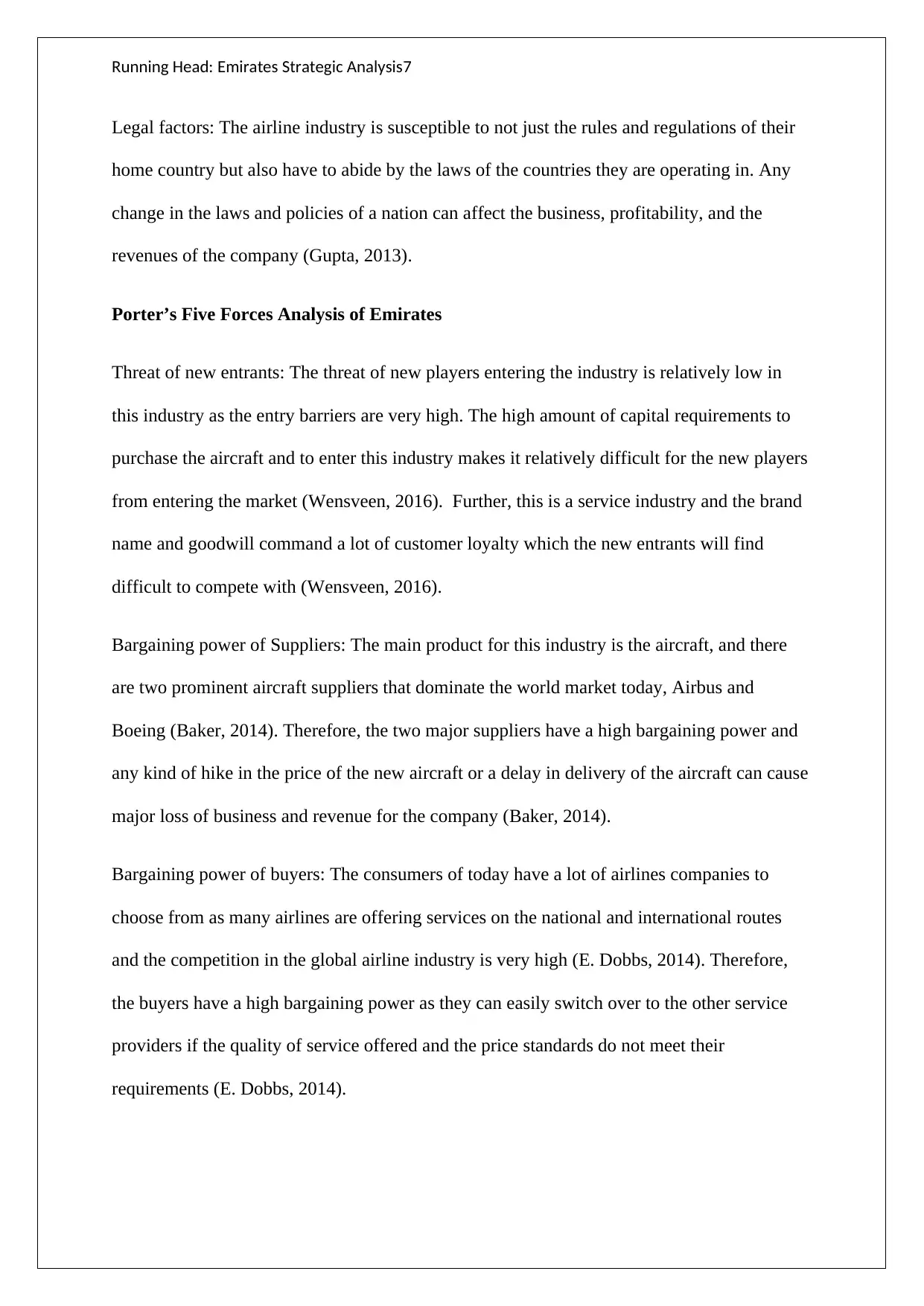
Running Head: Emirates Strategic Analysis7
Legal factors: The airline industry is susceptible to not just the rules and regulations of their
home country but also have to abide by the laws of the countries they are operating in. Any
change in the laws and policies of a nation can affect the business, profitability, and the
revenues of the company (Gupta, 2013).
Porter’s Five Forces Analysis of Emirates
Threat of new entrants: The threat of new players entering the industry is relatively low in
this industry as the entry barriers are very high. The high amount of capital requirements to
purchase the aircraft and to enter this industry makes it relatively difficult for the new players
from entering the market (Wensveen, 2016). Further, this is a service industry and the brand
name and goodwill command a lot of customer loyalty which the new entrants will find
difficult to compete with (Wensveen, 2016).
Bargaining power of Suppliers: The main product for this industry is the aircraft, and there
are two prominent aircraft suppliers that dominate the world market today, Airbus and
Boeing (Baker, 2014). Therefore, the two major suppliers have a high bargaining power and
any kind of hike in the price of the new aircraft or a delay in delivery of the aircraft can cause
major loss of business and revenue for the company (Baker, 2014).
Bargaining power of buyers: The consumers of today have a lot of airlines companies to
choose from as many airlines are offering services on the national and international routes
and the competition in the global airline industry is very high (E. Dobbs, 2014). Therefore,
the buyers have a high bargaining power as they can easily switch over to the other service
providers if the quality of service offered and the price standards do not meet their
requirements (E. Dobbs, 2014).
Legal factors: The airline industry is susceptible to not just the rules and regulations of their
home country but also have to abide by the laws of the countries they are operating in. Any
change in the laws and policies of a nation can affect the business, profitability, and the
revenues of the company (Gupta, 2013).
Porter’s Five Forces Analysis of Emirates
Threat of new entrants: The threat of new players entering the industry is relatively low in
this industry as the entry barriers are very high. The high amount of capital requirements to
purchase the aircraft and to enter this industry makes it relatively difficult for the new players
from entering the market (Wensveen, 2016). Further, this is a service industry and the brand
name and goodwill command a lot of customer loyalty which the new entrants will find
difficult to compete with (Wensveen, 2016).
Bargaining power of Suppliers: The main product for this industry is the aircraft, and there
are two prominent aircraft suppliers that dominate the world market today, Airbus and
Boeing (Baker, 2014). Therefore, the two major suppliers have a high bargaining power and
any kind of hike in the price of the new aircraft or a delay in delivery of the aircraft can cause
major loss of business and revenue for the company (Baker, 2014).
Bargaining power of buyers: The consumers of today have a lot of airlines companies to
choose from as many airlines are offering services on the national and international routes
and the competition in the global airline industry is very high (E. Dobbs, 2014). Therefore,
the buyers have a high bargaining power as they can easily switch over to the other service
providers if the quality of service offered and the price standards do not meet their
requirements (E. Dobbs, 2014).
Paraphrase This Document
Need a fresh take? Get an instant paraphrase of this document with our AI Paraphraser
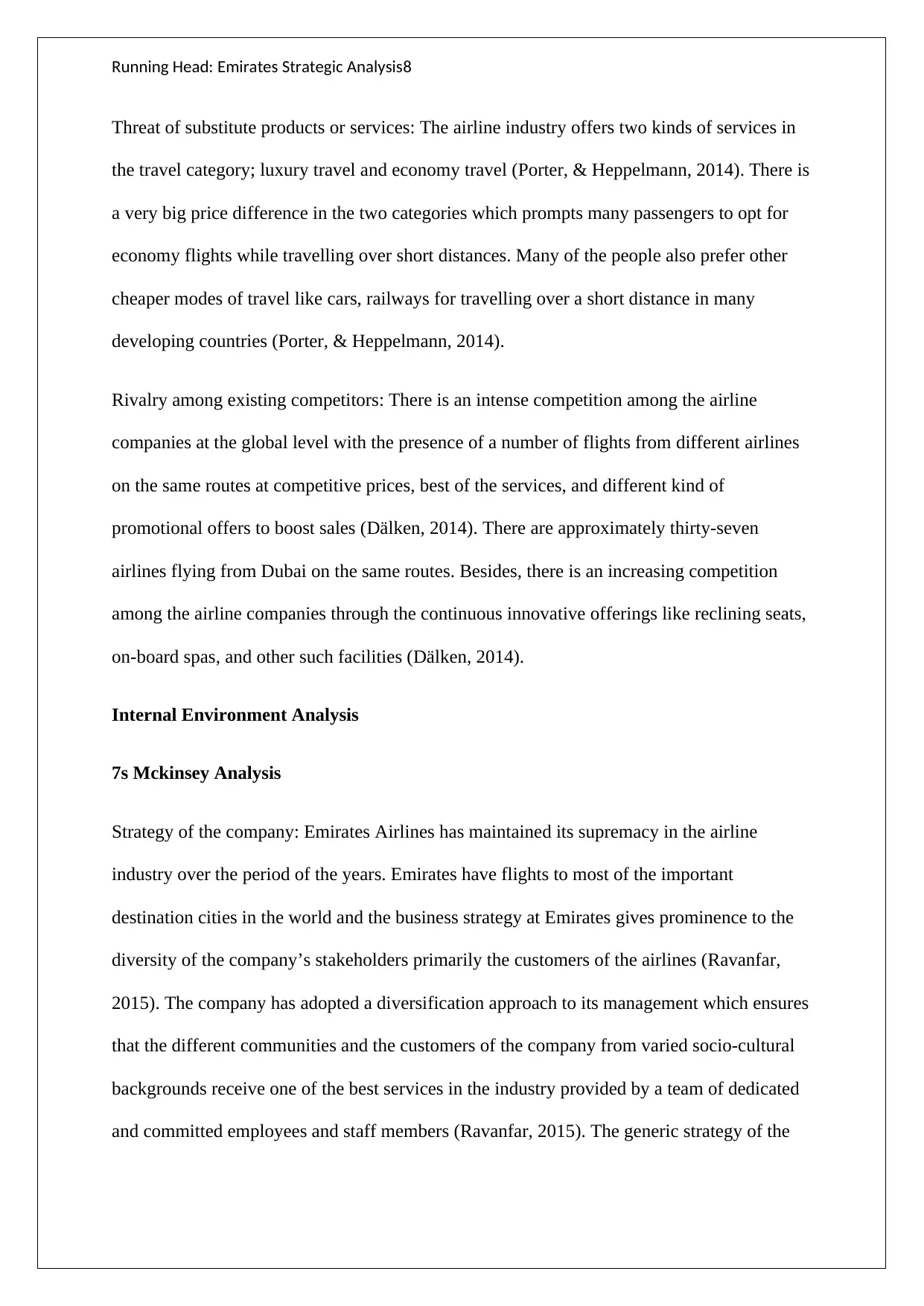
Running Head: Emirates Strategic Analysis8
Threat of substitute products or services: The airline industry offers two kinds of services in
the travel category; luxury travel and economy travel (Porter, & Heppelmann, 2014). There is
a very big price difference in the two categories which prompts many passengers to opt for
economy flights while travelling over short distances. Many of the people also prefer other
cheaper modes of travel like cars, railways for travelling over a short distance in many
developing countries (Porter, & Heppelmann, 2014).
Rivalry among existing competitors: There is an intense competition among the airline
companies at the global level with the presence of a number of flights from different airlines
on the same routes at competitive prices, best of the services, and different kind of
promotional offers to boost sales (Dälken, 2014). There are approximately thirty-seven
airlines flying from Dubai on the same routes. Besides, there is an increasing competition
among the airline companies through the continuous innovative offerings like reclining seats,
on-board spas, and other such facilities (Dälken, 2014).
Internal Environment Analysis
7s Mckinsey Analysis
Strategy of the company: Emirates Airlines has maintained its supremacy in the airline
industry over the period of the years. Emirates have flights to most of the important
destination cities in the world and the business strategy at Emirates gives prominence to the
diversity of the company’s stakeholders primarily the customers of the airlines (Ravanfar,
2015). The company has adopted a diversification approach to its management which ensures
that the different communities and the customers of the company from varied socio-cultural
backgrounds receive one of the best services in the industry provided by a team of dedicated
and committed employees and staff members (Ravanfar, 2015). The generic strategy of the
Threat of substitute products or services: The airline industry offers two kinds of services in
the travel category; luxury travel and economy travel (Porter, & Heppelmann, 2014). There is
a very big price difference in the two categories which prompts many passengers to opt for
economy flights while travelling over short distances. Many of the people also prefer other
cheaper modes of travel like cars, railways for travelling over a short distance in many
developing countries (Porter, & Heppelmann, 2014).
Rivalry among existing competitors: There is an intense competition among the airline
companies at the global level with the presence of a number of flights from different airlines
on the same routes at competitive prices, best of the services, and different kind of
promotional offers to boost sales (Dälken, 2014). There are approximately thirty-seven
airlines flying from Dubai on the same routes. Besides, there is an increasing competition
among the airline companies through the continuous innovative offerings like reclining seats,
on-board spas, and other such facilities (Dälken, 2014).
Internal Environment Analysis
7s Mckinsey Analysis
Strategy of the company: Emirates Airlines has maintained its supremacy in the airline
industry over the period of the years. Emirates have flights to most of the important
destination cities in the world and the business strategy at Emirates gives prominence to the
diversity of the company’s stakeholders primarily the customers of the airlines (Ravanfar,
2015). The company has adopted a diversification approach to its management which ensures
that the different communities and the customers of the company from varied socio-cultural
backgrounds receive one of the best services in the industry provided by a team of dedicated
and committed employees and staff members (Ravanfar, 2015). The generic strategy of the
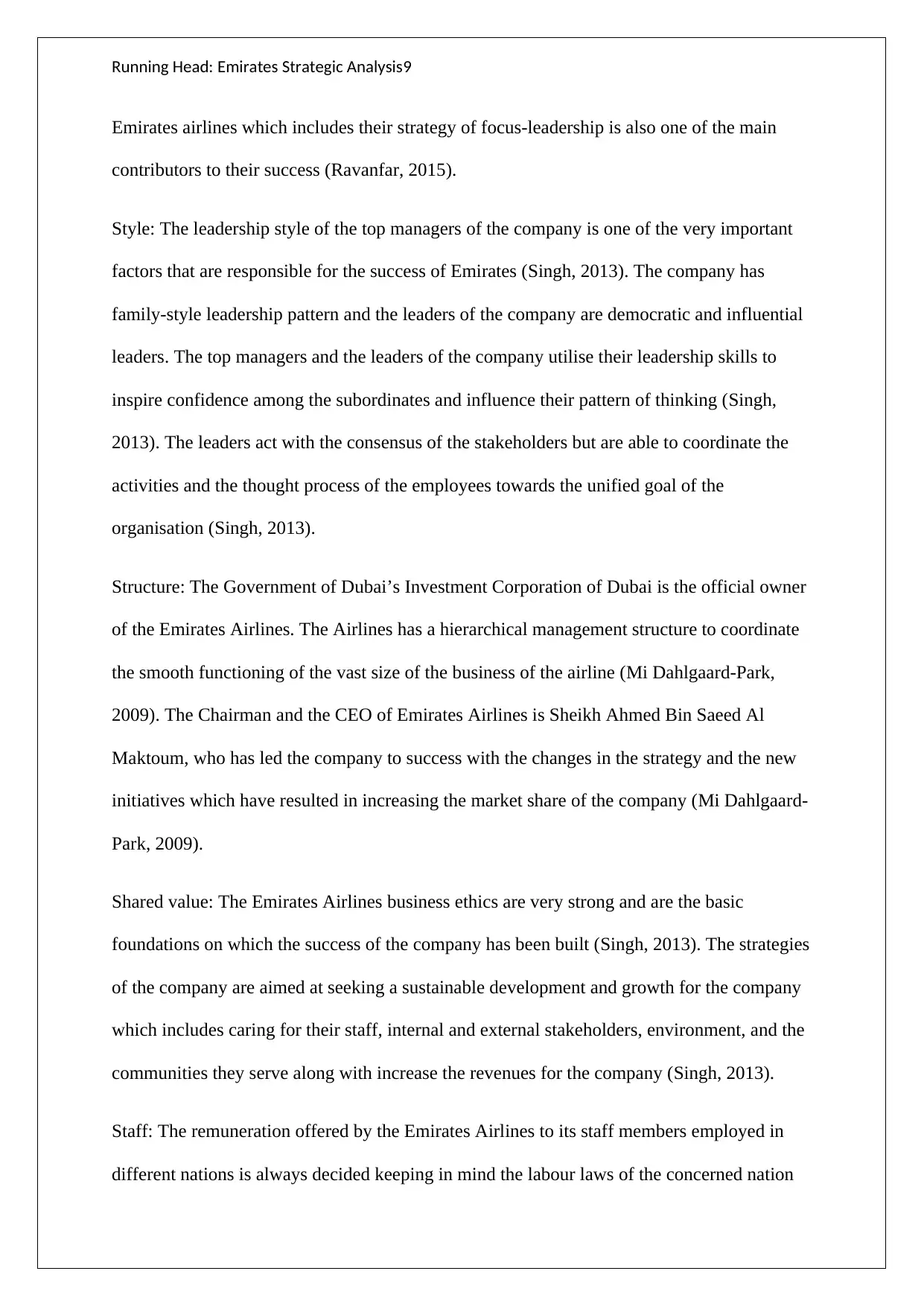
Running Head: Emirates Strategic Analysis9
Emirates airlines which includes their strategy of focus-leadership is also one of the main
contributors to their success (Ravanfar, 2015).
Style: The leadership style of the top managers of the company is one of the very important
factors that are responsible for the success of Emirates (Singh, 2013). The company has
family-style leadership pattern and the leaders of the company are democratic and influential
leaders. The top managers and the leaders of the company utilise their leadership skills to
inspire confidence among the subordinates and influence their pattern of thinking (Singh,
2013). The leaders act with the consensus of the stakeholders but are able to coordinate the
activities and the thought process of the employees towards the unified goal of the
organisation (Singh, 2013).
Structure: The Government of Dubai’s Investment Corporation of Dubai is the official owner
of the Emirates Airlines. The Airlines has a hierarchical management structure to coordinate
the smooth functioning of the vast size of the business of the airline (Mi Dahlgaard-Park,
2009). The Chairman and the CEO of Emirates Airlines is Sheikh Ahmed Bin Saeed Al
Maktoum, who has led the company to success with the changes in the strategy and the new
initiatives which have resulted in increasing the market share of the company (Mi Dahlgaard-
Park, 2009).
Shared value: The Emirates Airlines business ethics are very strong and are the basic
foundations on which the success of the company has been built (Singh, 2013). The strategies
of the company are aimed at seeking a sustainable development and growth for the company
which includes caring for their staff, internal and external stakeholders, environment, and the
communities they serve along with increase the revenues for the company (Singh, 2013).
Staff: The remuneration offered by the Emirates Airlines to its staff members employed in
different nations is always decided keeping in mind the labour laws of the concerned nation
Emirates airlines which includes their strategy of focus-leadership is also one of the main
contributors to their success (Ravanfar, 2015).
Style: The leadership style of the top managers of the company is one of the very important
factors that are responsible for the success of Emirates (Singh, 2013). The company has
family-style leadership pattern and the leaders of the company are democratic and influential
leaders. The top managers and the leaders of the company utilise their leadership skills to
inspire confidence among the subordinates and influence their pattern of thinking (Singh,
2013). The leaders act with the consensus of the stakeholders but are able to coordinate the
activities and the thought process of the employees towards the unified goal of the
organisation (Singh, 2013).
Structure: The Government of Dubai’s Investment Corporation of Dubai is the official owner
of the Emirates Airlines. The Airlines has a hierarchical management structure to coordinate
the smooth functioning of the vast size of the business of the airline (Mi Dahlgaard-Park,
2009). The Chairman and the CEO of Emirates Airlines is Sheikh Ahmed Bin Saeed Al
Maktoum, who has led the company to success with the changes in the strategy and the new
initiatives which have resulted in increasing the market share of the company (Mi Dahlgaard-
Park, 2009).
Shared value: The Emirates Airlines business ethics are very strong and are the basic
foundations on which the success of the company has been built (Singh, 2013). The strategies
of the company are aimed at seeking a sustainable development and growth for the company
which includes caring for their staff, internal and external stakeholders, environment, and the
communities they serve along with increase the revenues for the company (Singh, 2013).
Staff: The remuneration offered by the Emirates Airlines to its staff members employed in
different nations is always decided keeping in mind the labour laws of the concerned nation
⊘ This is a preview!⊘
Do you want full access?
Subscribe today to unlock all pages.

Trusted by 1+ million students worldwide

Running Head: Emirates Strategic Analysis10
and are at competitive rates to the prevailing industry norms (Mi Dahlgaard-Park, 2009). The
company also offers a profit share to all the eligible members of its staff based on the
performance of the company. The profit share offered is between the two to fourteen weeks
of the basic pay of the concerned employee. The airline also offers the air tickets at reduced
rates for the staff and also the family members of the staff (Mi Dahlgaard-Park, 2009).
System: The Company’s strategy of development in the Information Technology to achieve a
competitive edge in the fast-growing digital market is one of the very important strategies of
the company. The company is making investments in the development of the self-check
services and the e-business systems (Ravanfar, 2015). The development of the Information
Technology systems is the key requirement of the airline to help in the smooth running and
the coordination of the activities of the vast operations of the branches of the company which
are spread across the different geographical locations around the world (Ravanfar, 2015).
Skills: The Emirates Airlines follows a strategy of the extensive aviation training of all its
employees. The Emirates has its own training centre which is known as the ‘Emirates
Aviation University’, which trains the employees and the prospective candidates for the
company and helps them acquire the knowledge and skills which are necessary for the
strategic growth of the company (The Emirates Air Line., n.d.). The company also has in-
house or internal training centre which offers more development and training programs for
the employees to help them polish their skills for advancement in the company (Taran, Boer,
& Lindgren, 2015).
The BCG Matrix of Emirates Airlines
Cash Cow: The Economy flights can be considered the cash cow of the company which is
also considered the foundation of Emirates Airlines. Prior to the Emirates introducing the
economy flights in the company the economy class market was dominated by other players
and are at competitive rates to the prevailing industry norms (Mi Dahlgaard-Park, 2009). The
company also offers a profit share to all the eligible members of its staff based on the
performance of the company. The profit share offered is between the two to fourteen weeks
of the basic pay of the concerned employee. The airline also offers the air tickets at reduced
rates for the staff and also the family members of the staff (Mi Dahlgaard-Park, 2009).
System: The Company’s strategy of development in the Information Technology to achieve a
competitive edge in the fast-growing digital market is one of the very important strategies of
the company. The company is making investments in the development of the self-check
services and the e-business systems (Ravanfar, 2015). The development of the Information
Technology systems is the key requirement of the airline to help in the smooth running and
the coordination of the activities of the vast operations of the branches of the company which
are spread across the different geographical locations around the world (Ravanfar, 2015).
Skills: The Emirates Airlines follows a strategy of the extensive aviation training of all its
employees. The Emirates has its own training centre which is known as the ‘Emirates
Aviation University’, which trains the employees and the prospective candidates for the
company and helps them acquire the knowledge and skills which are necessary for the
strategic growth of the company (The Emirates Air Line., n.d.). The company also has in-
house or internal training centre which offers more development and training programs for
the employees to help them polish their skills for advancement in the company (Taran, Boer,
& Lindgren, 2015).
The BCG Matrix of Emirates Airlines
Cash Cow: The Economy flights can be considered the cash cow of the company which is
also considered the foundation of Emirates Airlines. Prior to the Emirates introducing the
economy flights in the company the economy class market was dominated by other players
Paraphrase This Document
Need a fresh take? Get an instant paraphrase of this document with our AI Paraphraser

Running Head: Emirates Strategic Analysis11
like the Qatar airlines. However, after the launch of economy class by Emirates, many people
have switched their preference to Emirates economy flights (Jarzabkowski, & Kaplan, 2015).
The company has been performing steadily in the economy segment in the western countries
and the Middle East, but the Asian market has not been fully tapped by the Emirates
economy flights. The sales from the Asian region are not constant and have proved to be a
setback in the revenues of the company (Jarzabkowski, & Kaplan, 2015). The company has
focused its strategy to improve the experience of the economy class customers and has
refurbished the economy aircraft cabins. The experience of the economy class passengers in
the Boeing 777 have been positive in the last few years proving that the strategy of the
company is gaining success in the market (Jarzabkowski, & Kaplan, 2015).
Stars: The first-class and the business segments of the Emirates Airlines are the business
leaders and the stars of Emirates operations. These two are counted among the flagship
services offered by the company and enjoy a substantially high market share in the rapidly
growing aviation industry (Jurevicius, 2013). Emirates has utilised the full potential of these
two services and made good investments in them which has helped in growing their market
share even more. With an upsurge in the economy and the income of the travellers the desire
to enjoy the services of the first class and the business class will increase further providing
further growth opportunities to the Emirates Airlines (Jurevicius, 2013). The airlines should
concentrate on maintaining the star services on a global level and ensure that the quality of
the services being offered remains uniform across the Middle Eastern markets and the South
Asian economies (Jurevicius, 2013).
Question Marks: The Emirates Airlines has recently launched its new service, the Emirates
Holidays which although has a very high potential but has a very low market share presently.
The investment in the venture is much higher as compared to the revenues generated from the
like the Qatar airlines. However, after the launch of economy class by Emirates, many people
have switched their preference to Emirates economy flights (Jarzabkowski, & Kaplan, 2015).
The company has been performing steadily in the economy segment in the western countries
and the Middle East, but the Asian market has not been fully tapped by the Emirates
economy flights. The sales from the Asian region are not constant and have proved to be a
setback in the revenues of the company (Jarzabkowski, & Kaplan, 2015). The company has
focused its strategy to improve the experience of the economy class customers and has
refurbished the economy aircraft cabins. The experience of the economy class passengers in
the Boeing 777 have been positive in the last few years proving that the strategy of the
company is gaining success in the market (Jarzabkowski, & Kaplan, 2015).
Stars: The first-class and the business segments of the Emirates Airlines are the business
leaders and the stars of Emirates operations. These two are counted among the flagship
services offered by the company and enjoy a substantially high market share in the rapidly
growing aviation industry (Jurevicius, 2013). Emirates has utilised the full potential of these
two services and made good investments in them which has helped in growing their market
share even more. With an upsurge in the economy and the income of the travellers the desire
to enjoy the services of the first class and the business class will increase further providing
further growth opportunities to the Emirates Airlines (Jurevicius, 2013). The airlines should
concentrate on maintaining the star services on a global level and ensure that the quality of
the services being offered remains uniform across the Middle Eastern markets and the South
Asian economies (Jurevicius, 2013).
Question Marks: The Emirates Airlines has recently launched its new service, the Emirates
Holidays which although has a very high potential but has a very low market share presently.
The investment in the venture is much higher as compared to the revenues generated from the
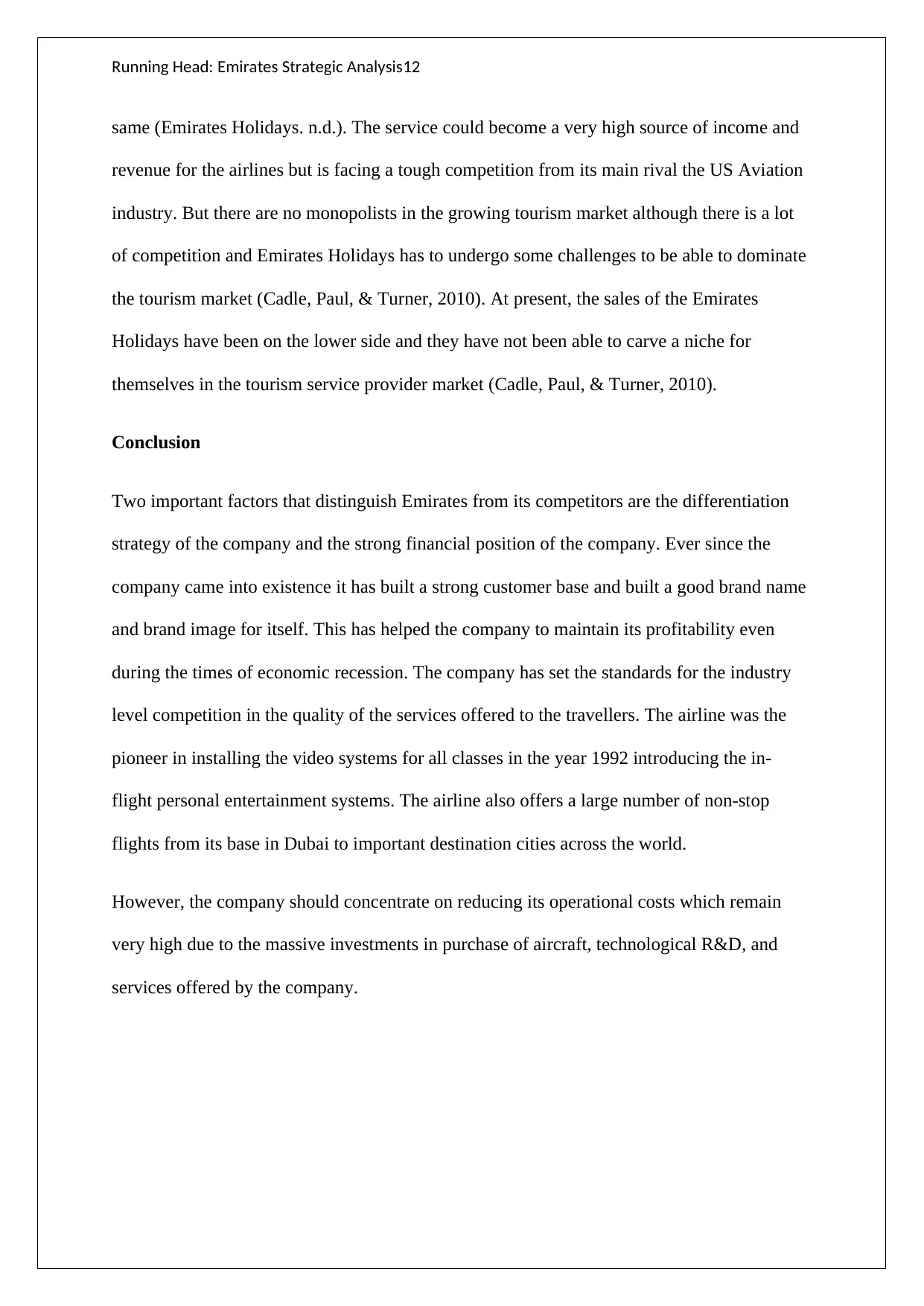
Running Head: Emirates Strategic Analysis12
same (Emirates Holidays. n.d.). The service could become a very high source of income and
revenue for the airlines but is facing a tough competition from its main rival the US Aviation
industry. But there are no monopolists in the growing tourism market although there is a lot
of competition and Emirates Holidays has to undergo some challenges to be able to dominate
the tourism market (Cadle, Paul, & Turner, 2010). At present, the sales of the Emirates
Holidays have been on the lower side and they have not been able to carve a niche for
themselves in the tourism service provider market (Cadle, Paul, & Turner, 2010).
Conclusion
Two important factors that distinguish Emirates from its competitors are the differentiation
strategy of the company and the strong financial position of the company. Ever since the
company came into existence it has built a strong customer base and built a good brand name
and brand image for itself. This has helped the company to maintain its profitability even
during the times of economic recession. The company has set the standards for the industry
level competition in the quality of the services offered to the travellers. The airline was the
pioneer in installing the video systems for all classes in the year 1992 introducing the in-
flight personal entertainment systems. The airline also offers a large number of non-stop
flights from its base in Dubai to important destination cities across the world.
However, the company should concentrate on reducing its operational costs which remain
very high due to the massive investments in purchase of aircraft, technological R&D, and
services offered by the company.
same (Emirates Holidays. n.d.). The service could become a very high source of income and
revenue for the airlines but is facing a tough competition from its main rival the US Aviation
industry. But there are no monopolists in the growing tourism market although there is a lot
of competition and Emirates Holidays has to undergo some challenges to be able to dominate
the tourism market (Cadle, Paul, & Turner, 2010). At present, the sales of the Emirates
Holidays have been on the lower side and they have not been able to carve a niche for
themselves in the tourism service provider market (Cadle, Paul, & Turner, 2010).
Conclusion
Two important factors that distinguish Emirates from its competitors are the differentiation
strategy of the company and the strong financial position of the company. Ever since the
company came into existence it has built a strong customer base and built a good brand name
and brand image for itself. This has helped the company to maintain its profitability even
during the times of economic recession. The company has set the standards for the industry
level competition in the quality of the services offered to the travellers. The airline was the
pioneer in installing the video systems for all classes in the year 1992 introducing the in-
flight personal entertainment systems. The airline also offers a large number of non-stop
flights from its base in Dubai to important destination cities across the world.
However, the company should concentrate on reducing its operational costs which remain
very high due to the massive investments in purchase of aircraft, technological R&D, and
services offered by the company.
⊘ This is a preview!⊘
Do you want full access?
Subscribe today to unlock all pages.

Trusted by 1+ million students worldwide
1 out of 17
Related Documents
Your All-in-One AI-Powered Toolkit for Academic Success.
+13062052269
info@desklib.com
Available 24*7 on WhatsApp / Email
![[object Object]](/_next/static/media/star-bottom.7253800d.svg)
Unlock your academic potential
Copyright © 2020–2025 A2Z Services. All Rights Reserved. Developed and managed by ZUCOL.





